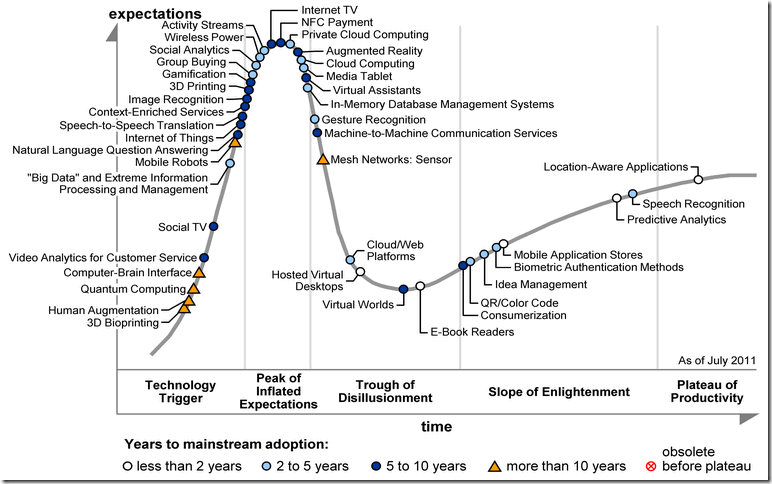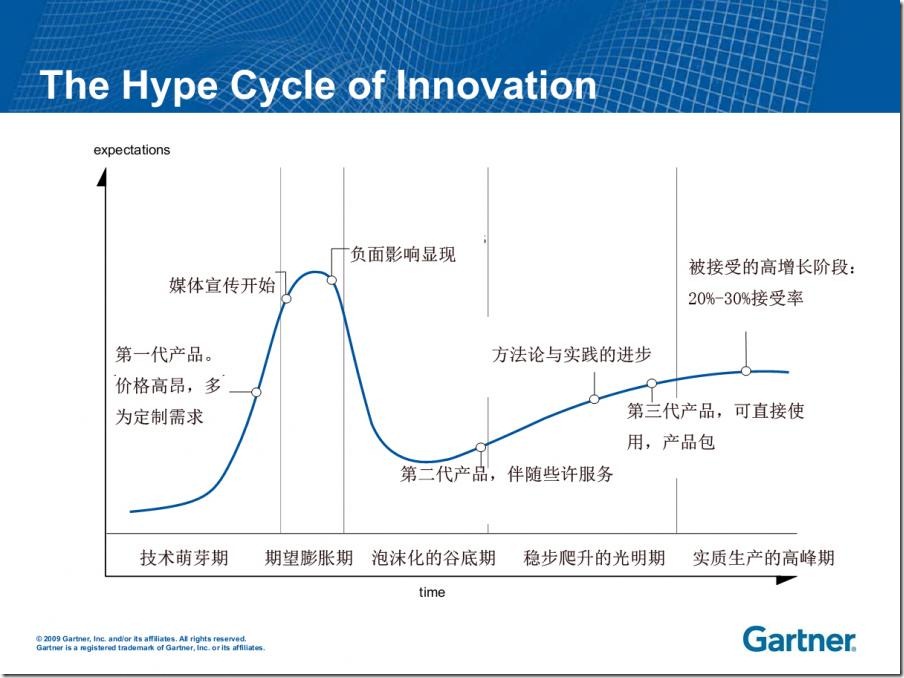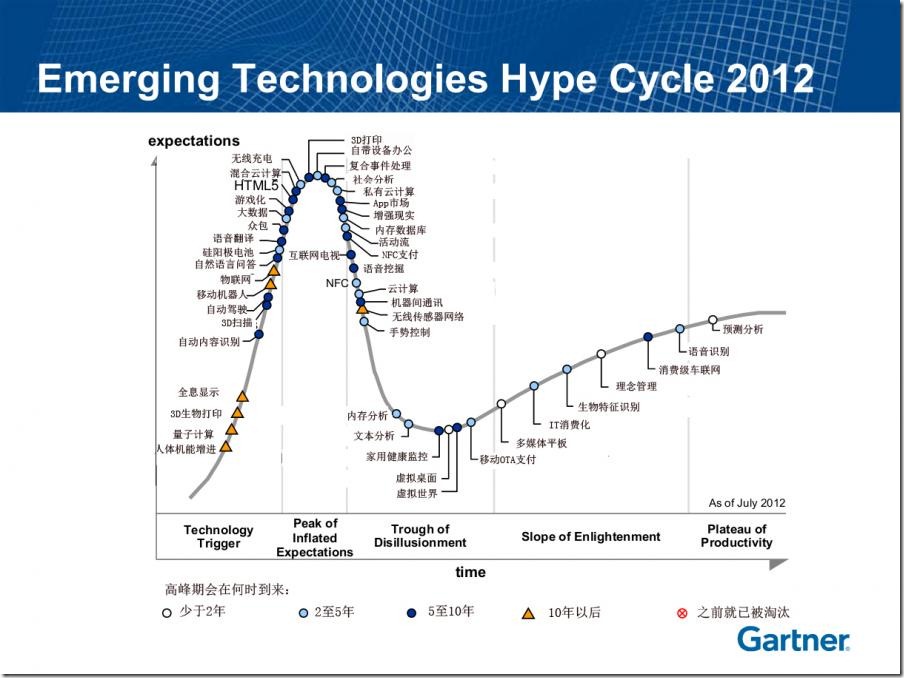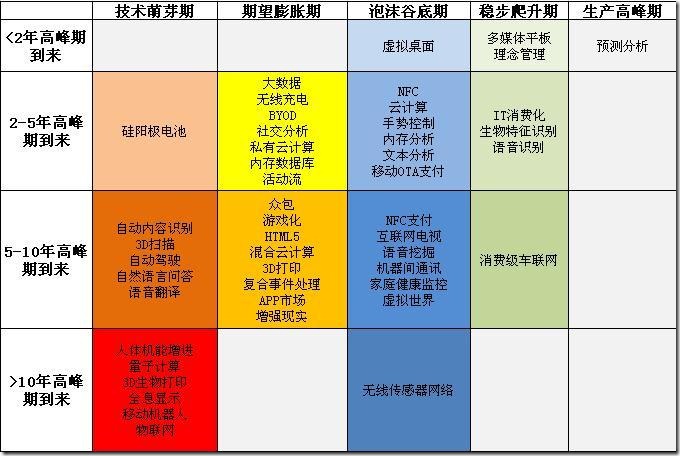英文稿:
The “Hype Cycle for Emerging Technologies” report is the longest-running annual Hype Cycle, providing a cross-industry perspective on the technologies and trends that IT managers should consider in developing emerging-technology portfolios (see Figure 1).
“Hype Cycle for Emerging Technologies” targets strategic planning, innovation and emerging technology professionals by highlighting a set of technologies that will have broad-ranging impact across the business,” said Jackie Fenn, vice president and Gartner fellow. “It is the broadest aggregate Gartner Hype Cycle, featuring technologies that are the focus of attention because of particularly high levels of hype, or those that may not be broadly acknowledged but that Gartner believes have the potential for significant impact.”
“Themes from this year’s Emerging Technologies Hype Cycle include ongoing interest and activity in social media, cloud computing and mobile,” Ms. Fenn said. “On the social media side, social analytics, activity streams and a new entry for group buying are close to the peak, showing that the era of sky-high valuations for Web 2.0 startups is not yet over. Private cloud computing has taken over from more-general cloud computing at the top of the peak, while cloud/Web platforms have fallen toward the Trough of Disillusionment since 2010. Mobile technologies continue to be part of most of our clients’ short- and long-range plans and are present on this Hype Cycle in the form of media tablets, NFC payments, quick response (QR)/color codes, mobile application stores and location-aware applications.”
Transformational technologies that will hit the mainstream in less than five years include highly visible areas, such as media tablets and cloud computing, as well as some that are more IT-specific, such as in-memory database management systems, big data, and extreme information processing and management. In the long term, beyond the five-year horizon, 3D printing, context-enriched services, the “Internet of Things” (called the “real-world Web” in earlier Gartner research), Internet TV and natural language question answering will be major technology forces. Looking more than 10 years out, 3D bioprinting, human augmentation, mobile robots and quantum computing will also drive transformational change in the potential of IT.
Many of the technologies featured on this Hype Cycle contribute to the four themes featured in Gartner’s recent report on top technology trends “Technology Trends That Matter”:
The connected world: Advances in embedded sensors, processing and wireless connectivity are bringing the power of the digital world to objects and places in the physical world. This is a slow-moving area, but one that is now accelerating with the growing pervasiveness of low-cost, embedded sensors and cameras. Relevant entries on this year’s Hype Cycle include the broad trend referred to as the Internet of Things; identification technologies, such as NFC payments (which will lead to broader use of NFC for other applications); QR/color code and image recognition; application layers, such as augmented reality, context-enriched services and location-aware applications; and communication technologies, such as machine-to-machine communication services and sensor mesh networks. Although this area will take at least another decade to unfold fully, many interesting and profitable opportunities will arise along the way.
Interface trends: User interfaces are another slow-moving area with significant recent activity. Speech recognition was on the original 1995 Hype Cycle and has still not reached maturity, and computer-brain interfaces will evolve for at least another 10 years before moving out of research and niche status. However, a new entry for natural language question answering recognizes the impressive and highly visible achievement of IBM’s Watson computer in winning TV’s Jeopardy! general knowledge quiz against champion human opponents. Gesture recognition has also been launched into the mainstream through Microsoft’s Kinect gaming systems, which is now being hacked by third parties to create a range of application interfaces. Other areas continue to progress more slowly, including speech-to-speech translation, augmented reality and virtual assistants, while virtual worlds remain entrenched in the trough after peaking in 2007.
Analytical advances: Supporting the storage and manipulation of raw data to derive greater value and insight, these technologies continue to grow in capability and applicability. Predictive analytics is approaching maturity, but researchers and developers continue to apply and improve the core techniques for new data sources. Image recognition is driving new capabilities in search, retail and social media, and also contributes to advances in other areas, such as augmented reality and video analytics, for customer service. Social analytics continues to take advantage of new sources and types of social information. Computational advances, such as in-memory database management systems and big data, take the scope and scale to new levels.
New digital frontiers: Crossing the traditional boundaries of IT, new capabilities are reaching levels of performance and pricing that will fundamentally reshape processes and even industries. Examples on this year’s Hype Cycle include 3D printing and bioprinting (of human tissue), and mobile robots.
“Many Gartner clients use Hype Cycles as part of their technology-planning process, often drawing from multiple Hype Cycles, augmented with industry- or company-specific topics to create their own Hype Cycles and Priority Matrices,” said Ms. Fenn. “Technology providers use Hype Cycles as a way to understand the likely market reaction to their products and services based on the adopter community’s expectations and attitudes. Investors watch for technologies that are on the rise in a Hype Cycle to try to catch them before the Peak of Inflated Expectations or at the beginning of the Slope of Enlightenment before they move into mainstream adoption.”
"The theme of this year's Hype Cycle is the concept of 'tipping points.' We are at an interesting moment, a time when many of the scenarios we've been talking about for a long time are almost becoming reality," said Hung LeHong, research vice president at Gartner. "The smarter smartphone is a case in point. It's now possible to look at a smartphone and unlock it via facial recognition, and then talk to it to ask it to find the nearest bank ATM. However, at the same time, we see that the technology is not quite there yet. We might have to remove our glasses for the facial recognition to work, our smartphones don't always understand us when we speak, and the location-sensing technology sometimes has trouble finding us."
Although the Hype Cycle presents technologies individually, Gartner encourages enterprises to consider the technologies in sets or groupings, because so many new capabilities and trends involve multiple technologies working together. Often, one or two technologies that are not quite ready can limit the true potential of what is possible. Gartner refers to these technologies as "tipping point technologies" because, once they mature, the scenario can come together from a technology perspective.
Some of the more significant scenarios, and the tipping point technologies, need to mature so that enterprises and governments can deliver new value and experiences to customers and citizens include:
Any Channel, Any Device, Anywhere — Bring Your Own Everything
The technology industry has long talked about scenarios in which any service or function is available on any device, at anytime and anywhere. This scenario is being fueled by the consumerization trend that is making it acceptable for enterprise employees to bring their own personal devices into the work environment. The technologies and trends featured on this Hype Cycle that are part of this scenario include BYOD, hosted virtual desktops, HTML5, the various forms of cloud computing, silicon anode batteries and media tablets. Although all these technologies and trends need to mature for the scenario to become the norm, HTML 5, hosted virtual networks and silicon anode batteries are particularly strong tipping point candidates.
Smarter Things
A world in which things are smart and connected to the Internet has been in the works for more than a decade. Once connected and made smart, things will help people in every facet of their consumer, citizen and employee lives. There are many enabling technologies and trends required to make this scenario a reality. On the 2012 Hype Cycle, Gartner has included autonomous vehicles, mobile robots, Internet of Things, big data, wireless power, complex-event processing, Internet TV, activity streams, machine-to-machine communication services, mesh networks: sensor, home health monitoring and consumer telematics. The technologies and trends that are the tipping points to success include machine-to-machine communication services, mesh networks: sensor, big data, complex-event processing and activity streams.
Big Data and Global Scale Computing at Small Prices
This broad scenario portrays a world in which analytic insight and computing power are nearly infinite and cost-effectively scalable. Once enterprises gain access to these resources, many improved capabilities are possible, such as better understanding customers or better fraud reduction. The enabling technologies and trends on the 2012 Hype Cycle include quantum computing, the various forms of cloud computing, big data, complex-event processing, social analytics, in-memory database management systems, in-memory analytics, text analytics and predictive analytics. The tipping point technologies that will make this scenario accessible to enterprises, governments and consumers include cloud computing, big data and in-memory database management systems.
The Human Way to Interact With Technology
This scenario describes a world in which people interact a lot more naturally with technology. The technologies on the Hype Cycle that make this possible include human augmentation, volumetric and holographic displays, automatic content recognition, natural-language question answering, speech-to-speech translation, big data, gamification, augmented reality, cloud computing, NFC, gesture control, virtual worlds, biometric authentication methods and speech recognition. Many of these technologies have been "emerging" for multiple years and are starting to become commonplace, however, a few stand out as tipping point technologies including natural-language question answering and NFC.
What Payment Could Really Become
This scenario envisions a cashless world in which every transaction is an electronic one. This will provide enterprises with efficiency and traceability, and consumers with convenience and security. The technologies on the 2012 Hype Cycle that will enable parts of this scenario include NFC payment, mobile over the air (OTA) payment and biometric authentication methods. Related technologies will also impact the payment landscape, albeit more indirectly. These include the Internet of Things, mobile application stores and automatic content recognition. The tipping point will be surpassed when NFC payment and mobile OTA payment technologies mature.
The Voice of the Customer Is on File
Humans are social by nature, which drives a need to share — often publicly. This creates a future in which the "voice of customers" is stored somewhere in the cloud and can be accessed and analyzed to provide better insight into them. The 2012 Hype Cycle features the following enabling technologies and trends: automatic content recognition, crowdsourcing, big data, social analytics, activity streams, cloud computing, audio mining/speech analytics and text analytics. Gartner believes that the tipping point technologies are privacy backlash and big data.
3D Print It at Home
In this scenario, 3D printing allows consumers to print physical objects, such as toys or housewares, at home, just as they print digital photos today. Combined with 3D scanning, it may be possible to scan certain objects with a smartphone and print a near-duplicate. Analysts predict that 3D printing will take more than five years to mature beyond the niche market.
Additional information is available in "Gartner's Hype Cycle for Emerging Technologies, 2012" at www.gartner.com/hypecycles. The Special Report includes a video in which Ms. Fenn provides more details regarding this year's Hype Cycles, as well as links to the 92 Hype Cycle reports.
Mr. LeHong and Ms. Fenn will provide additional analysis during the Gartner webinar "Emerging Technologies Hype Cycle: What's Hot for 2012 to 2013" today, August 16, at 10 a.m. EDT and 1 p.m. EDT. To register for one of these complimentary webinars, please visit http://my.gartner.com/portal/server.pt?open=512&objID=202&mode=2&PageID=5553&resId=2054421&ref=Webinar-Calendar
中文稿:
前不久,Gartner公布了一份关于2012-2013年技术曲线成熟度(Hype Cycles)的报告。自1995年起,Gartner就开始关注伴随着每一次的新技术和创新出现而来的炒作与幻灭,并开始跟踪技术沿着周期发展的趋势,研究其间的共同模式,以此为各类组织何时在哪里进行技术部署提供指南。
Gartner总结的技术成熟曲线分为五大阶段:技术萌芽期(Technology Trigger),期望膨胀期(Peak of Inflated Expectations),泡沫化的谷底期(Trough of Disillusionment),稳步爬升的光明期(Slope of Enlightenment),实质生产的高峰期(Plateau of productivity)。
这份报告涵括的前沿技术种类多达1900种,分布在92个领域。Gartner指出,在今年,大数据(Big Data)、物联网(Internet of Things)、内存计算(In-Memory Computing)、云服务中介(Cloud Service Brokerage)、呼叫中心基础设施(Contact Center Infrastructure)、人力资本管理软件(Human Capital Management Software)、战略业务能力(Strategic Business Capabilities)、未来货币(The Future of Money)、操作工艺冲击(Operational Technology Impact)以及绿色IT技术(Green IT and Sustainability in China)成为这一曲线关注的对象。
这份报告涵括的前沿技术种类多达1900种,分布在92个领域。Gartner指出,在今年,大数据(Big Data)、物联网(Internet of Things)、内存计算(In-Memory Computing)、云服务中介(Cloud Service Brokerage)、呼叫中心基础设施(Contact Center Infrastructure)、人力资本管理软件(Human Capital Management Software)、战略业务能力(Strategic Business Capabilities)、未来货币(The Future of Money)、操作工艺冲击(Operational Technology Impact)以及绿色IT技术(Green IT and Sustainability in China)成为这一曲线关注的对象。
上图是48项技术在2012年时,于技术成熟度曲线上的坐标。
1人体机能增进(human augmentation)。根据Gartner预测,有两种新近崛起的趋势,2020年以后其市场规模将超过10亿美元。其一是人类机能增进(human augmentation),这种新技术可提升感知与体能表现,融为人体一部分的概念现也逐步实现,未来可望大幅改善人类生活。日本Cyberdyne公司已经研制出一种名为“Hal”的服装,就是类似的外骨骼。它可以帮助失去运动功能的人恢复运动能力,其主要原理就是先获得负责传递肢体运动信息的神经电信号,然后将其转化为服装的运动指令。此外,智慧型义肢及视觉增进装置也是其应用之一。
2.量子计算(quatuam computing)微型芯片极小,放在某人的大拇指上就像一个小点。但一段时间以来,科学家一直在努力将之变得更小,达到原子级。这就是所谓的量子计算机,其数据处理速度能让如今最快的计算机相形见拙。
3.3D生物打印(3D Bioprinting)。2010年,美国生物技术公司Organovo开发出一款生物打印机,可利用患者自身细胞“打印”静脉。该3D生物打印机有两个打印头,一个放置最多达8万个人体细胞,被称为“生物墨”;另一个可打印“生物纸”。所谓生物纸其实主要成分是水的凝胶,可用作细胞生长的支架。2011年,哈佛大学医学院的研究人员通过新型自动化生物打印方法实现了胚胎干细胞的生物打印。
4.全息显示(Volumetric and Holographic Displays)虚拟女性歌手“初音未来”登台演唱时,采用的就是全息显示技术。
5.自动内容识别(Automatic Content Recognition)一些新型创新企业正在专注于更为智能的电视机,在电视机内置入自动内容识别系统(ACR),让电视机不再是傻瓜设备。这种技术能够识别你正在观看的节目的声音,并同步获取相关的社交评论。
6.3D扫描(3D Scanners)通过侦测并分析现实世界中物体或环境的形状(几何构造)与外观资料(如颜色、反射率等),收集到的资料常被用来三维重建为实际物体的数码模型,并应用于3D打印等领域。
7.自动驾驶(Autonomous Vehicles):谷歌的自动驾驶汽车已经行驶了一年多,只出过一次交通事故,还是被人追尾。
8.移动机器人(Mobile Robots):是一个集环境感知、动态决策与规划、行为控制与执行等多功能于一体的综合系统。
9.物联网(Internet of Things):物联网是一个基于互联网、传统电信网等信息承载体,让所有能够被独立寻址的普通物理对象实现互联互通的网络。它具有普通对象设备化、自治终端互联化和普适服务智能化3个重要特征。
10.自然语言问答( Natural- Language Question Answering)自动问答是自然语言处理领域的一个重要方向,旨在让用户直接用自然语言提问并获得答案。用户直接用自然语言与问答系统交互;问答系统直接返回问题的答案。
11.硅阳极电池 (Silicon Anode Batteries)如果用硅阳极取代石墨阳极,锂离子电池每个单元就可存储高达10倍的能量。但是,制造商不使用硅,因为随着电池的充放电,这样的阳极会迅速退化。
12.语音翻译(Speech-to-Speech Translation),即让计算机实现从一种语言的语音到另一种语言的语音翻译的过程。
13.众包(Crowdsourcing)同样都是将工作分配给别人,外包是包给特定的乙方,而众包而是包给不特定的人群。众包是一种分布式的问题解决和生产模式,问题以公开招标的方式传播给未知的解决方案提供者群体。
14.大数据( Big Data)简单一点可以理解为超出传统数据管理工具处理能力的大规模、复杂的数据集合。这包括在社交网站上的数据、在线金融交易数据、公司记录、气象监测数据等等。
15.游戏化(Gamification),游戏化的内涵是将游戏的机制运用到非游戏环境中,衡量并影响用户的行为。公司在诸如社交媒体上的推荐量、用户生产的内容、转化、再次访问量和全过程用户忠诚度等用户驱动的业务指标上可以获得15%到250%的提升。
16. HTML5:HTML 5并非仅仅用来表示Web内容,它的新使命是将Web带入一个成熟的应用平台,在HTML 5平台上,视频,音频,图象,动画,以及同电脑的交互都被标准化。
17.混合云计算(Hybrid Cloud Computing):将多个云计算平台整合在一起进行计算,所以需要云计算作为基础。
18.无线充电( Wireless Power)让电能像数据一样进行无线传输,消除随身携带许许多多电线的必要性,使用户在没有电线的情况下也能给自己的移动设备充电。
19.3d打印(3D Printing):3D 打印是对“添加法制造技术”的一种形象化的描述,即在原来二维打印的基础上,通过逐层叠加的方式打印出三维的物体。
20.BYOD(Bring Your Own Device):BYOD时代是为手机应运而生,然后发展到平板电脑。越来越多的公司给员工配备笔记本电脑,用于商业和个人使用。
21.复合事件处理(Complex - Event Processing)
22.社交分析(Social Analytics)
23.私有云计算 (Private Cloud Computing)整合服务器资源,并按需动态划分计算资源(CPU、内存、储存空间、带宽等)的一种架构,所以可以说是所有云计算的基础架构。
24. App市场( Application Stores)亦称应用商店,专门为移动设备手机,平板电脑等提供收费(免费)游戏,应用下载服务的电子应用商店。
25.增强现实(Augmented Reality)在人们接触到的真实世界上,叠加虚拟电子信息,对真实世界的信息进行增强或者扩张,帮助利用者们从事各种活动。
26.内存数据库(In-Memory Database Management Systems)
27.活动流(Activity Streams)是某个人在一个特定网站上的所有活动的信息集合。随着 Web 用户越来越依赖于活动流来获取信息,能够发布和订阅活动流数据变得很重要。但是因为 RSS 和 Atom 不支持社交元数据,所以我们需要一种新的格式来发布社交活动。
28. NFC支付(NFC Payment)是在智能手机普及的基础上衍生出的一种手机支付方式。NFC是near field communication的缩写,译作“近场通讯”。
29.互联网电视(Internet TV):真正的互联网电视将成为主流。电视制造商正推出能轻松访问内置互联网的电视机。人们很快就能完全无需有线电视和卫星电视,而直接通过互联网观看一切自己想看的东西。
30.语音挖掘 (Audio Mining/Speech Analytics)
31.NFC:由飞利浦公司和索尼公司共同开发的NFC是一种非接触式识别和互联技术,可以在移动设备、消费类电子产品、PC 和智能控件工具间进行近距离无线通信。NFC 提供了一种简单、触控式的解决方案,可以让消费者简单直观地交换信息、访问内容与服务。
32.云计算(Cloud Computing):是基于互联网的相关服务的增加、使用和交付模式,通常涉及通过互联网来提供动态易扩展且经常是虚拟化的资源。
33.机器间通讯(Machine-to-Machine Communication Services)
34.无线传感器网络( Mesh Networks: Sensor)无线传感器网络就是由部署在监测区域内大量的廉价微型传感器节点组成,通过无线通信方式形成的一个多跳自组织网络。它能够实时监测和采集网络分布区域内的各种检测对象的信息,并将这些信息发送到网关节点,以实现复杂的指定范围内目标检测与跟踪。
35.手势控制( Gesture Control)让你轻移手指就能控制设备。
36.内存分析( In-Memory Analytics)即直接在内存中访问数据,相对于访问储存在硬盘中的数据,这大大缩短了分析与回复的时间,能很好地解决大数据带来的数据分析压力。
37.文本分析(Text Analytics),能够帮助企业从基于文本的内容中提取潜在、有价值的业务见解.这些内容包括从word文档和邮件到社交媒体流(Facebook、Twitter和LinkedIn等)中的博文。
38.家用健康监控(Home Health Monitoring),通过使用含多种传感器的嵌入式医疗诊断设备,监测收集家庭中的医学数据,并利用无线网络将这些实测数据发送到相应的健康监测中心,与用户的永久性电子病历相融合。
39.虚拟桌面(Hosted Virtual Desktops)是一种基于服务器的计算模型,将所有桌面虚拟机在数据中心进行托管并统一管理;同时用户能够获得完整PC的使用体验。未来我们可以通过任何设备,在任何地点,任何时间访问在网络上的属于我们个人的桌面系统。
40.虚拟世界( Virtual Worlds)
41.移动OTA支付(Mobile OTA Payment),OTA,即Over-the-air的缩写,通过移动通信进行交互。与NFC相比,这一技术依赖移动通信的信号。
42.多媒体平板(Media Tablets)多媒体平板电脑和智能电话是移动设备中最大的两个发展趋势。
43. IT消费化(Consumerization)最初主要指企业员工们希望采用私有的电子设备处理日常工作时,也能享受与传统办公环境一致的应用体验,目前也扩展到企业外部用户,而云计算、虚拟化和移动设备正在使这种需求成为可能。
44.生物特征识别(Biometric Authentication Methods)利用人的生理特征或行为特征,来进行个人身份的鉴定。常见的有指纹识别、人脸识别、虹膜识别、说话人识别、手形识别、掌纹识别、签名识别、步态识别等。
45.理念管理( Idea Management)
46.消费级车联网( Consumer Telematics)以无线语音、数字通信和人造卫星的GPS系统为基础,通过汽车交换信息的技术。通过定位系统和无线通信网,向驾驶员和乘客提供交通信息、应付紧急情况的对策、远距离车辆诊断和互联网服务。
47.语音识别(Speech Recognition),就是让机器通过识别和理解过程,把语音信号转变为相应的文本或命令。语音识别的应用领域非常广泛,常见的应用系统有:语音输入系统,语音控制系统,或者做到自然语言问答。
48.预测分析(Predictive Analytics)即通过大量的数据分析,预测消费者未来的购买习惯,为其提供量身定制的产品和服务。
Source:
http://sembassy.com/2011/10/gartner-hype-cycle-2012/
http://zh.scribd.com/doc/100797860/60/Microblogging
http://www.forbeschina.com/review/201210/0020518.shtml
转自:
Gartner报告:未来一年48项即将大热的技术趋势 (Hype Cycle for Emerging Technologies)
http://www.cnblogs.com/youth0826/archive/2012/10/24/2737075.html



